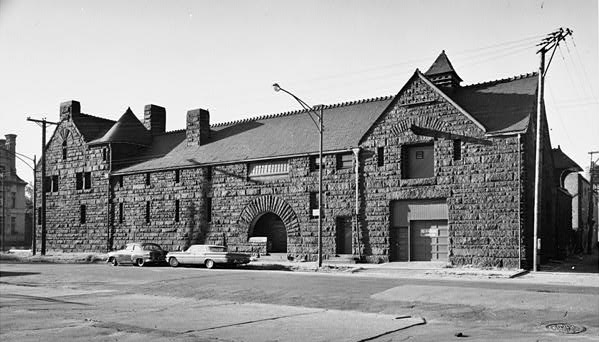- John J. Glessner House
Infobox_nrhp | name =Glessner, John J., House
nrhp_type =nhl

caption =An exterior view from the northwest.
location= 1800 S. Prairie Avenue,Chicago, Illinois
lat_degrees = 41 | lat_minutes = 51 | lat_seconds = 27.39 | lat_direction = N
long_degrees = 87 | long_minutes = 37 | long_seconds = 15.78 | long_direction = W
area =
built =1885
architect=Henry Hobson Richardson
architecture= Other, Romanesque
designated=January 07 ,1976 cite web|url=http://tps.cr.nps.gov/nhl/detail.cfm?ResourceId=917&ResourceType=Building
title=Glessner, John J., House|accessdate=2008-07-20|work=National Historic Landmark summary listing|publisher=National Park Service]
added =April 17 ,1970
governing_body = Private
refnum=70000233 cite web|url=http://www.nr.nps.gov/|title=National Register Information System|date=2006-03-15|work=National Register of Historic Places|publisher=National Park Service] The John J. Glessner House is an important 19th-century residence located at 1800 S.Prairie Avenue ,Chicago, Illinois . It was designed in 1885-1886 by architectHenry Hobson Richardson and completed in late 1887. The property was designated aChicago Landmark on October 14, 1970. The site was listed in theNational Register of Historic Places on April 17, 1970 and as aNational Historic Landmark on January 7, 1976.John J. Glessner
John J. Glessner was a partner in the firm of Warder, Bushnell & Glessner, a farm machinery manufacturer headquartered in Springfield Ohio. Immediately after his marriage in 1870 to Frances Macbeth, Glessner relocated to Chicago where he opened a branch office. In 1902, the firm and four others, including McCormick and Deering, merged to form International Harvester, which became the fourth largest corporation in the country. Glessner was appointed vice president and continued in that capacity until his death in 1936 at the age of 92.
During the late 19th century, Chicago's most prestigious residential street was the South Side's Prairie Avenue. Enjoying economic success, Glessner decided to build a home for his family on Prairie and 18th Streets. He chose one of the young nation's foremost
architects , H.H. Richardson.Henry Hobson Richardson
Eager to develop a style of architecture that would reflect what he saw as the
musculature of the fast-growing United States, the late-19-century architect Henry Hobson Richardson developed what would be called theRichardsonian Romanesque style. The Richardsonian Romanesque style took elements of EuropeanRomanesque architecture from buildings constructed in the 11th and 12th centuries, and adapted them to American idioms.For example, the heavy, rough-cut facing stones of Romanesque architecture were no longer necessary for
engineering reasons. Architects and builders had discovered more efficient ways for walls to distribute and bear a building's weight. Richardson believed that what was no longer necessary for function could be made to serve a new purpose of form, by creating a new visual language of individual separation and privacy.The significance of the Glessner House
The innovative floorplan and design of the Glessner house rank it as one of the most important residential commissions of the 19th century. The walls of the house are pushed close to the lot lines, allowing for a spacious private courtyard within. The courtyard allowed abundant natural light to enter the main rooms of the house through south-facing windows, and also provided a level of privacy rarely achieved in urban residences. Additionally, a long servant hall is placed along the north side of the house, buffering the family spaces from the noise and dirt of 18th Street, and the brutal winter winds. The exterior of the house is clad in Braggville granite, laid in courses of various heights, giving the house a strong horizontal appearance. Ornamentation is minimal, and includes an arch of stylized foliage over the front entrance and a series of carved capitals on the second floor columns. The design was distinctly different from the other houses on Prairie Avenue, and many neighbors did not understand it. Sleeping-car CEO
George Pullman , who lived across the street in a traditional Second Empire mansion, said, "I do not know what I have ever done to have that thing staring me in the face every time I go out of my door."Later History
After John Glessner died in 1936, the house was given to the American Institute of Architects, who returned it to the family when they decided they could not afford the upkeep necessary. In 1937, the family deeded the house to the Armour Institute (precursor to the present day Illinois Institute of Technology). The Institute leased the house to the Lithographic Technical Foundation in 1945, which installed large printing presses in many of the rooms, and conducted research for the printing industry. When the foundation moved to Pittsburgh in the early 1960s, the house was threatened with demolition. Eventually a group of architects and preservation minded citizens banded together to save the house, and purchased it in 1966 for just $35,000. Within a few years, the Glessner descendants began returning original furnishings.
The House Today
The house opened for public tours in 1971 and many of the rooms have been accurately restored to their original appearance. The collection of decorative objects and furnishings is especially significant, as the Glessners were sophisticated collectors of both English and American arts and crafts. Objects and furniture by
William Morris , William DeMorgan, Galle, Isaac Scott, A. H. Davenport, and others are found throughout the house.The Glessner House Museum, a non-profit 501(c)(3) corporation was formed in 1994 to administer the property. Several thousand people visit the site annually for tours and programs.References
External links
* [http://www.glessnerhouse.org/house.html Glessner House Museum]
* [http://www.ci.chi.il.us/Landmarks/G/GlessnerHouse.html Chicago Landmark]
Wikimedia Foundation. 2010.
